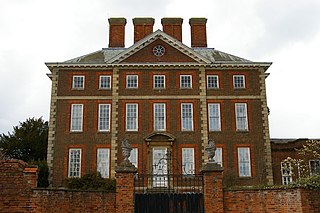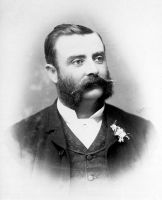Related Research Articles

Victorian architecture is a series of architectural revival styles in the mid-to-late 19th century. Victorian refers to the reign of Queen Victoria (1837–1901), called the Victorian era, during which period the styles known as Victorian were used in construction. However, many elements of what is typically termed "Victorian" architecture did not become popular until later in Victoria's reign, roughly from 1850 and later. The styles often included interpretations and eclectic revivals of historic styles (see Historicism). The name represents the British and French custom of naming architectural styles for a reigning monarch. Within this naming and classification scheme, it followed Georgian architecture and later Regency architecture, and was succeeded by Edwardian architecture.

The Queen Anne style of British architecture refers to either the English Baroque architecture of the time of Queen Anne or the British Queen Anne Revival form that became popular during the last quarter of the 19th century and the early decades of the 20th century. In other English-speaking parts of the world, New World Queen Anne Revival architecture embodies entirely different styles.

Toorak is a suburb of Melbourne, Victoria, Australia, 5 km (3.1 mi) south-east of Melbourne's Central Business District, located within the City of Stonnington local government area, on Boonwurrung Land. Toorak recorded a population of 12,817 at the 2021 census.

The Queen Victoria Market is a major landmark in the central business district (CBD) of Melbourne, Victoria, Australia. Covering over seven hectares, it is the largest open air market in the Southern Hemisphere.

William Pitt was an Australian architect and politician. Pitt is best known as one of the outstanding architects of the "boom" era of the 1880s in Melbourne, designing some of the city's most elaborate High Victorian commercial buildings. He worked in a range of styles including Gothic Revival, Italianate, French Second Empire, and his own inventive eclectic compositions. He had a notable second career after the crash of the 1890s, becoming a specialist in theatres and industrial buildings.

East Melbourne is an inner-city suburb in Melbourne, Victoria, Australia, 2 km (1.2 mi) east of Melbourne's Central Business District, located within the City of Melbourne local government area. East Melbourne recorded a population of 4,896 at the 2021 census.

The Italianate style was a distinct 19th-century phase in the history of Classical architecture. Like Palladianism and Neoclassicism, the Italianate style drew its inspiration from the models and architectural vocabulary of 16th-century Italian Renaissance architecture, synthesising these with picturesque aesthetics. The style of architecture that was thus created, though also characterised as "Neo-Renaissance", was essentially of its own time. "The backward look transforms its object," Siegfried Giedion wrote of historicist architectural styles; "every spectator at every period—at every moment, indeed—inevitably transforms the past according to his own nature."

Government House is the official residence of the governor of Victoria, currently Linda Dessau. It is located in Kings Domain, Melbourne, next to the Royal Botanic Gardens.

In Great Britain and former British colonies, a Victorian house generally means any house built during the reign of Queen Victoria. During the Industrial Revolution, successive housing booms resulted in the building of many millions of Victorian houses which are now a defining feature of most British towns and cities.

The Mansions is a heritage-listed row of six terrace houses at 40 George Street, Brisbane City, City of Brisbane, Queensland, Australia. It was designed by G.H.M. Addison and built in 1889 by RE Burton. It was added to the Queensland Heritage Register on 21 August 1992.

Edinburgh Gardens is a large park located in the inner Melbourne suburb of North Fitzroy. It is bounded by Brunswick Street and St Georges Road to the west, the curve of Alfred Crescent to the north and east, and Freeman Street to the south. It was created from a grant of land in March 1862 by Queen Victoria and laid out by Clement Hodgkinson, who designed many of Melbourne's parks and gardens. At approximately 24 hectares in size, the park is large by inner urban standards.

Stonington is a private residence and former Australian Government House located in the Melbourne suburb of Malvern, at 336 Glenferrie Road. The house was built for John Wagner, a partner in Cobb and Co coaches. Stonington gave its name to the City of Stonnington, a Melbourne municipality.

Terrace houses in Australia are mostly Victorian and Edwardian era terraced houses or replicas, almost always found in the older, inner city areas of the major cities, mainly Sydney and Melbourne. Terraced housing was introduced to Australia in the 19th century. Their architectural work was based on those in London and Paris, which had the style a century earlier.
Knight & Kerr was a business partnership established in the 1850s between John George Knight and Peter Kerr. Their practice was important in the development of Melbourne as a city during the boom period led by the gold rush, providing the rapidly expanding state capital with many works of cultural and political significance. They were architects appointed with the responsibility for the design of noted public buildings in Melbourne, Australia; their most well known design being the Parliament House of Victoria. John Knight and Peter Kerr were also both members of The Royal British Institute of Architects.

d'Estaville, also spelled D'Estaville, is a large bluestone Italianate-style heritage-listed house located at 7 Barry Street in the Melbourne suburb of Kew, Victoria, Australia. Designed by architects Knight & Kerr for politician and long term Chief Justice of Victoria, Sir William Foster Stawell, d’Estaville was completed in 1859. d’Estaville is a fine and unusual example of the Italianate style, and the only residential work of Knight & Kerr, designers of the Victorian Parliament House.

The Drewsville Mansion is a historic house on Old Cheshire Turnpike in the Drewsville village of Walpole, New Hampshire, United States. Built in 1880, it is a regionally rare example of vernacular Stick/Eastlake style architecture, located in an area that has predominantly even older buildings. The building was listed on the National Register of Historic Places in 1996.

Harris Terrace is a heritage-listed terrace house at 68 George Street, Brisbane City, City of Brisbane, Queensland, Australia. It was designed by J & G Cowlishaw and built from c. 1866 to c. 1867 by Mr Clarke. It is also known as Harris Court. It was added to the Queensland Heritage Register on 21 October 1992.

Architecture in Bathurst, a regional city in the state of New South Wales, Australia includes a unique collection of architecture. This architecture reflects Bathurst's history from colonial through to recent times, with many examples remaining intact. Historical buildings range from workers cottages, terrace houses, mansions, slab huts, industrial, commercial buildings and grand civic structures.

ABC Radio Studios are heritage-listed radio studios at 236 Quay Street, Rockhampton City, Rockhampton, Rockhampton Region, Queensland, Australia. It was added to the Australian Commonwealth Heritage List on 14 September 2009.

Milton Terrace is a heritage-listed series of terrace houses located at 1-19 Lower Fort Street, in the inner city Sydney suburb of Millers Point in the City of Sydney local government area of New South Wales, Australia. It was built from 1880 to 1882. The property was added to the New South Wales State Heritage Register on 2 April 1999.
References
- ↑ Allom, Lovell, Sanderson; Australia. Department of Housing and Construction; Australia. Department of Defence; Allom, Lovell, Sanderson Pty. Ltd (1984), RAAF Frognall conservation management plan, Department of Housing and Construction. Victoria/Tasmania Region, retrieved 7 September 2017
{{citation}}: CS1 maint: multiple names: authors list (link) - ↑ "Frognall". Australian e-Heritage Portal. Retrieved 12 March 2017.
- ↑ ""Frognall" Retained by Air Force". The Age . No. 28, 572. Victoria, Australia. 20 November 1946. p. 18. Retrieved 7 September 2017– via National Library of Australia.
- ↑ "Frognall - Statement of Significance". National Trust Database. Retrieved 12 March 2017.
- ↑ "Frognall". Victorian Heritage Database. Retrieved 12 March 2017.